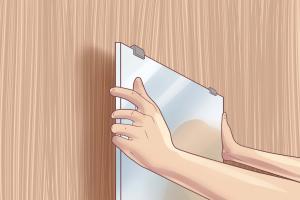Ultimate Guide: How to Hang a Mirror Perfectly in Your Home

-
Quick Links:
- Introduction
- Tools Needed
- Choosing the Right Spot
- Measuring and Marking
- Installation Methods
- Step-by-Step Guide
- Common Mistakes to Avoid
- Case Studies and Examples
- Expert Insights
- FAQs
Introduction
Hanging a mirror can dramatically enhance the ambiance of any room. Whether it’s for functionality or aesthetic appeal, knowing how to hang a mirror properly is an essential skill for any homeowner or DIY enthusiast. In this comprehensive guide, we will explore everything from selecting the right tools to advanced installation techniques, ensuring you achieve a flawless hanging.Tools Needed
Before you start, gather the following tools:- Measuring tape
- Pencil
- Level
- Drill
- Wall anchors (if needed)
- Stud finder
- Mirror clips or D-rings (depending on mirror type)
Choosing the Right Spot
Choosing the right location for your mirror is crucial. Here are some factors to consider:- Functionality: Are you hanging it in a hallway, bathroom, or living room? Each area serves different purposes.
- Height: The mirror should be at eye level for optimal viewing.
- Lighting: Consider natural light sources and how they will reflect in the mirror.
- Style: Ensure the mirror complements the room’s decor.
Measuring and Marking
Once you've decided on the spot, it’s time to measure:- Use your measuring tape to determine the desired height.
- Mark the spot lightly with a pencil.
- Ensure the mark is level by using a level tool.
Installation Methods
There are several methods to hang a mirror, depending on its weight and style:- Heavy Mirrors: Use wall anchors and screws for heavy mirrors. Ensure you locate studs in the wall for secure installation.
- Medium Mirrors: You can use D-rings or hanging wire for medium-sized mirrors.
- Light Mirrors: Command strips can be an easy alternative for lightweight mirrors.
Step-by-Step Guide
Here’s a detailed step-by-step installation guide:Step 1: Prepare the Wall
Ensure the wall surface is clean and dry. Remove any dust or debris.Step 2: Mark Your Drill Points
Based on your chosen installation method, mark where your screws or anchors will go.Step 3: Drill Holes
Using a drill, create holes where you’ve marked. If you're using wall anchors, ensure they are the correct size.Step 4: Insert Wall Anchors
If using wall anchors, insert them into the drilled holes.Step 5: Hang the Mirror
Carefully lift the mirror and align it with the screws or hooks you’ve installed. Make sure it’s level.Step 6: Secure the Mirror
If your mirror has clips or additional securing mechanisms, use them to ensure it’s stable.Common Mistakes to Avoid
Here are some mistakes to avoid when hanging your mirror:- Not checking for studs in the wall
- Hanging the mirror too high or too low
- Using incorrect hardware for the weight of the mirror
- Neglecting to level the mirror before securing it
Case Studies and Examples
Consider the following case studies to illustrate the importance of proper mirror hanging techniques:Case Study 1: The Hallway Transformation
In a recent home renovation project, a homeowner transformed a narrow hallway by installing a large mirror. By strategically placing the mirror to reflect light from a nearby window, the hallway appeared wider and more inviting.Case Study 2: The Bathroom Upgrade
A bathroom remodel included a frameless mirror hung above the sink. Proper installation not only enhanced the functionality but also added a touch of elegance.Expert Insights
We spoke to several interior designers about mirror placement. Here’s what they had to say: > "Mirrors can create illusions of space and light. Always consider the angle at which the mirror will reflect before deciding on its placement." - Jane Doe, Interior Designer. > "The height of the mirror matters greatly. It should serve its purpose and enhance the aesthetics of the space." - John Smith, Home Decor Expert.FAQs
1. How high should I hang a mirror?
Typically, the center of the mirror should be at eye level, approximately 57-65 inches from the floor.
2. What type of hardware do I need for heavy mirrors?
For heavy mirrors, use wall anchors and screws that are rated for the weight of the mirror.
3. Can I hang a mirror without drilling?
Yes, for lightweight mirrors, adhesive hooks or command strips can be used as an alternative.
4. How do I know if my wall can support a mirror?
Use a stud finder to locate studs in your wall, which provide the best support for heavy items.
5. What if my mirror doesn't have hanging hardware?
You can purchase D-rings or mirror clips separately to facilitate hanging.
6. How can I protect the wall behind the mirror?
Consider using felt pads between the mirror and wall to avoid scratches.
7. Is it safe to hang a mirror over a bed?
While it can create a beautiful effect, ensure it is securely anchored to avoid accidents.
8. Can I use a mirror as a focal point in a room?
Absolutely! A large statement mirror can serve as a stunning focal point in any room.
9. How do I remove a mirror that’s been hung?
Carefully unscrew or unhook the mirror, ensuring to protect the wall and the mirror itself while removing it.
10. What are some creative ways to use mirrors in decor?
Mirrors can be used to create depth, reflect light, and enhance color schemes in your space.
Random Reads
- How to edit buildings in fortnite
- How to edit audio iphone
- Ultimate guide mailbox installation
- How to reboot from command prompt windows
- How to reboot dsl modem remotely
- Blinking orange light xfinity router
- How to create multiple email accounts
- How to shut down kindle paperwhite
- How to shut down windows
- Reset android phone factory settings